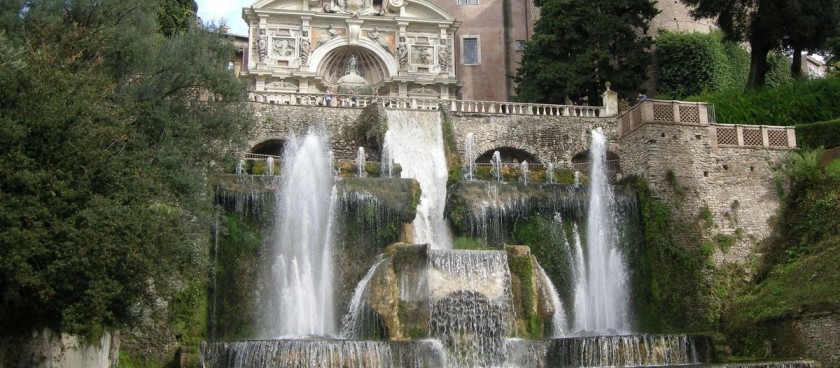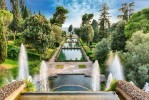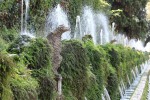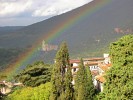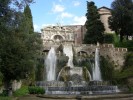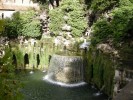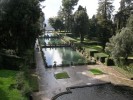- #IT23
- Piazza Trento, 5, 00019 Tivoli RM, Italy
- +390412719036
- villadestetivoli@vivaticket.com
- https://www.villadeste.com
- Working hours*:
From November, 1st:
8:30- 19:45 p.m. (18:45 p.m. last entrance)
Depending on the month, the garden closes at different time. - Prices*:
Adult € 13,00
Reduced ticket: € 2,00 for EU citizens between 18 and 25 years
FREE ENTRY(through presentation of a document stating one of the following conditions):
- to the citizens up to 17 years;
- to disabled people. - * - opening and closing times as well as entrance prices, are subject to alterations without notice. Visitors are advised to check before visiting.
- 41.9637590, 12.7962120 Copy to clipboard Copy
-
#Parks , #Museums , #Fountains
History
Villa d’Este, masterpiece of the Italian Garden, is included in the UNESCO world heritage list. With its impressive concentration of fountains, nymphs, grottoes, plays of water, and music, it constitutes a much-copied model for European gardens in the mannerist and baroque styles.
The garden is generally considered within the larger –and altogether extraordinary-- context of Tivoli itself: its landscape, art and history which includes the important ruins of ancient villas such as the Villa Adriana, as well as a zone rich in caves and waterfalls displaying the unending battle between water and stone. The imposing constructions and the series of terraces above terraces bring to mind the hanging gardens of Babylon, one of the wonders of the ancient world. The addition of water-- including an aqueduct tunneling beneath the city -- evokes the engineering skill of the Romans themselves.
Cardinal Ippolito II d’Este, after the disappointment of a failed bid for the papacy, brought back to life here the splendor of the courts of Ferrara, Rome and Fontainebleau and revived the magnificence of Villa Adriana. Governor of Tivoli from 1550, he immediately nurtured the idea of realizing a garden in the hanging cliffs of the “Valle gaudente”, but it was only after 1560 that his architectural and iconographic program became clear—brainchild of the painter-architect-archeologist Pirro Ligorio and realized by court architect Alberto Galvani.
The rooms of the Palace were decorated under the tutelage of the stars of the late Roman Mannerism, such as Livio Agresti, Federico Zuccari, Durante Alberti, Girolamo Muziano, Cesare Nebbia and Antonio Tempesta. The work was almost complete at the time of the Cardinal’s death (1572).
From 1605 Cardinal Alessandro d'Este gave the go-ahead to a new progam of interventions not only to restore and repair the vegetation and the waterworks, but also to create a new series of innovations to the layout of the garden and the decorations of the fountains.
Other works were carried out from 1660 – 70; these involved no less a figure than Gianlorenzo Bernini.
In the XVIIIth century the lack of maintenance led to the decay of the complex, which was aggravated by the property’s passage to the House of Hapsburg. The garden was slowly abandoned, the water works-- no longer used--fell into ruin, and the collection of ancient statues— enlarged under Cardinal Ippolito, was disassembled and scattered.
This state of decay continued without interruption until the middle of the XIXth century, when Gustav Adolf von Hohenlohe, who obtained in enfiteusi the villa from the Dukes of Modena in 1851, launched a series of works to pull the complex back from its state of ruin. Between 1867 and 1882 the Villa once again became a cultural point of reference, with the Cardinal frequently hosting the musician Franz Liszt (1811 - 1886), who composed Giochi d'acqua a Villa d'Este for piano while a guest here, and who in 1879 gave one of his final concerts.
At the outbreak of the first world war the villa became a property of the Italian State, and during the 1920s it was restored and opened to the public. Another, radical restoration was carried out immediately after the Second World War to repair the damage caused by the bombing of 1944. Due to particularly unfavorable environmental conditions, the restorations have continued practically without interruption during the past twenty years (among these it is worth noting the recent cleaning of the Organ Fountain and also the “Birdsong.”)
